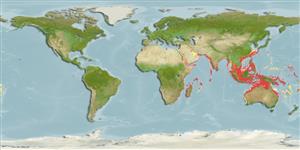Common names from other countries
Environment: milieu / climate zone / depth range / distribution range
Ecologia
marinhas associadas(os) a recifes; intervalo de profundidade 20 - 140 m (Ref. 58302). Deep-water; 30°N - 36°S, 22°E - 154°W
Indo-West Pacific: Red Sea and the Persian Gulf eastward to Sri Lanka; then from India to the Philippines and Oahu, Hawaii, north to the Ryukyu Islands (Ref. 559), south to northern Australia. Recently recorded from Reunion (Ref. 53568).
Tamanho / Peso / Idade
Maturity: Lm ? range ? - ? cm
Max length : 28.0 cm FL macho/indeterminado; (Ref. 3287)
Adults occur in the continental shelf (Ref. 7300). They form schools in depths from 50 to at least 130 m. They feed on epibenthic crustaceans and cephalopods (Ref. 37816). Maximum depth reported taken from Ref. 9773.
Ciclo de vida ou comportamento de acasalamento
Maturities | Reprodução | Spawnings | Egg(s) | Fecundities | Larvas
Paxton, J.R., D.F. Hoese, G.R. Allen and J.E. Hanley, 1989. Pisces. Petromyzontidae to Carangidae. Zoological Catalogue of Australia, Vol. 7. Australian Government Publishing Service, Canberra, 665 p. (Ref. 7300)
Status na Lista Vermelha da UICN (Ref. 130435)
CITES (Ref. 128078)
Not Evaluated
Ameaça para os humanos
Harmless
Uso pelos humanos
Pescarias: pouco comercial
Ferramentas
Relatórios especiais
Baixar XML
Fontes da internet
Estimates based on models
Preferred temperature (Ref.
115969): 22.9 - 28.3, mean 27.2 (based on 781 cells).
Índice de diversidade filogenética (Ref.
82804): PD
50 = 0.6250 [Uniqueness, from 0.5 = low to 2.0 = high].
Bayesian length-weight: a=0.01349 (0.00646 - 0.02815), b=2.96 (2.79 - 3.13), in cm Total Length, based on LWR estimates for this (Sub)family-body shape (Ref.
93245).
Nível Trófico (Ref.
69278): 4.1 ±0.48 se; based on food items.
Resiliência (Ref.
120179): Elevada, tempo mínimo de duplicação da população menor que 15 meses (Preliminary K or Fecundity.).
Fishing Vulnerability (Ref.
59153): Low vulnerability (21 of 100).
